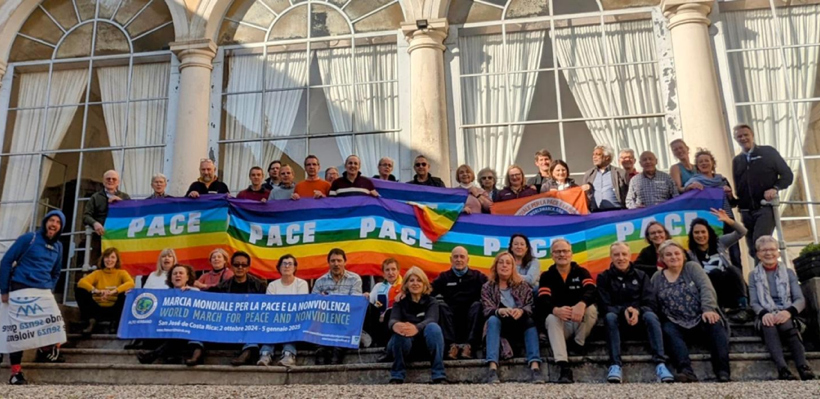From Friday 15 to Sunday 17 March, the European Coordination of the Third World March for Peace and Nonviolence met at the Castle of the Comboni Missionaries in Venegono Superiore (VA) for three days of dialogue, exchange, reflection, and enthusiasm in a very peaceful environment both inside the building and in the beautiful park outside.
About thirty delegates from various European countries and Italy (joined by another twenty-five remotely) worked on the path towards the World March of 2024-’25, building on the previous editions of 2009 and 2019-’20, in the hope of sowing seeds beyond this third edition and aiming for the fourth.
In the afternoon of Friday 15 March, each participant introduced themselves and described what was going on in the cities and provinces to which they belonged, showing their determination even though they were aware of the complexity of the moment and the difficulty of organizing a world march, where everything could be called into question, even in the face of a program planned down to the last detail. This was the case in Italy in February 2020, when in less than twenty-four hours it was decided not to continue the journey of the international delegation due to the imminent closure of Covid-19.
Saturday 16 March was an intense day. In the morning, the delegates were divided into groups and studied the documents (in several languages) that had already been made available to all the countries. Members of the Italian organizing team reiterated the central themes of the march:
- Support for the UN Treaty on the Prohibition of Nuclear Weapons, urging countries to ratify the TPNW and asking cities to push governments in this direction by joining the campaign of the International Coalition for the Abolition of Nuclear Weapons.
- The affirmation of conscientious objection as a universally recognized fundamental right, so that everyone has the real possibility of not contributing to nonviolence.
- The an urgent need to restore the credibility of the United Nations, and its democratization through the abolition of the right of veto in the Security Council, and the creation of an Environmental Security Council and a Socio-Economic Security Council.
- Guaranteeing the necessary conditions for the sustainability of the planet as a limited space that we must all be determined to take care of, and denouncing the continued plundering of natural resources by large multinationals.
- Non-discrimination, whether based on gender, race, ethnicity or religion, economic situation, etc.
- The culture of non-violence and active non-violence as a methodology of action is to be included in school curricula and university courses.
It was then proposed to expand the themes of denunciation and boycott of the arms trade and to include popular non-violent defense in the general proposal, on an experimental basis in Italy.
In the afternoon, thematic groups were formed on topics such as institutions, culture, education, communication/dissemination, physical marches in neighborhoods, cities, and villages, the Mediterranean Sea of Peace: hours of intense work, dialogue, and confrontation to continue to give meaning to what had begun, perhaps at an embryonic level, building on the experiences of previous editions of the World March. Much has changed politically, socially, and culturally from the first (2009-2010) to the second (2019-2020) and the third (2024-2025), but also the conditions on the Earth, where climate change has become an everyday reality.
The Third World March for Peace will leave San José, Costa Rica, on 2 October 2024 and return there on 5 January 2025, having completed its journey around the world. On Sunday 17th March in Venegono, the delegates discussed the delicate issue of the dates of arrival and departure from the various continents, given that the presence of the base team of the March in Europe is planned from around 1st to 15th November. The revision of the itinerary, which is currently underway, could lead to slight changes in the dates.
For Italy, the Organizing Committee is outlining a main route and two possible converging routes to make the most of different parts of the country. In previous editions, the entry into Europe had to take place in Moscow. Now it is hoped that, if geopolitical conditions allow, it will be possible to mark a specific moment between the Ukrainian and Russian borders, as was the case in 2009 with the presence on the border between North and South Korea (38th parallel).
During the Second World March in November 2019, a meeting was held at the Poy border between students and professors from the U. Andrés Bello University of El Salvador and the UCENM of Honduras. The “five-day war”, which left 5,000 dead, 14,000 wounded, and around 300,000 displaced, was recalled. Given that relations between the two countries are still tense at times, the young people proposed the signing of permanent peace treaties between the two countries, committing them to resolve conflicts non-violently through negotiations, with the United Nations mediating in the event of complications.
During the World March for Peace and Nonviolence, institutional events, meetings in schools and universities, and cultural moments in theatres will be organized, without forgetting places where conflicts exist. If possible, a stop will be made in these places to give a non-violent witness to peace and to transmit the hope that a different world is possible, together.
“Be the change you want to see in the world,” said Mahatma Gandhi.
For further information: info@theworldmarch.org










